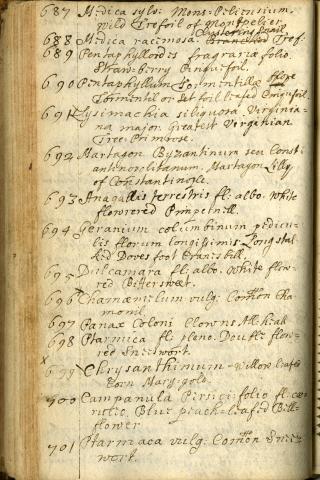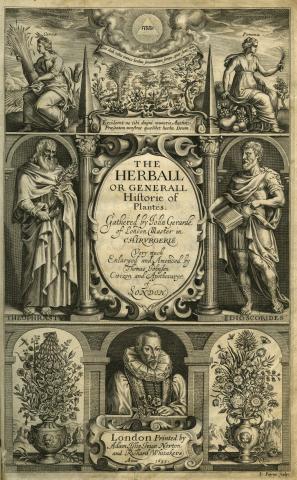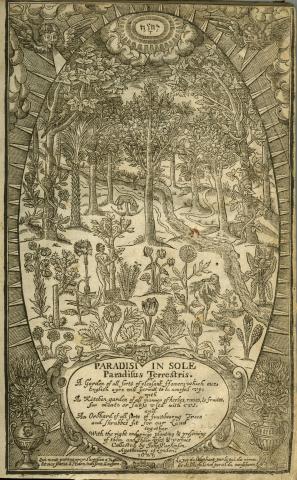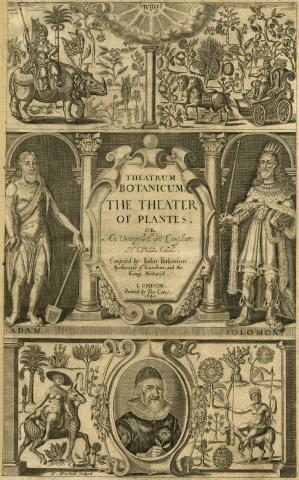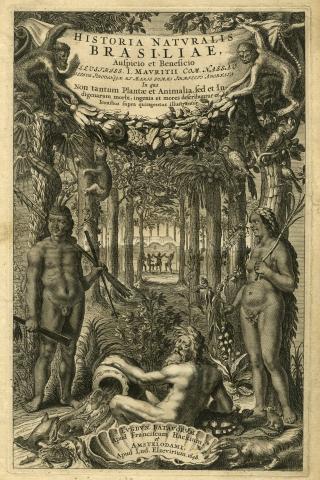Raw materials
Living and preserved plants, together with observations recorded in manuscripts and published books, were the sources of data used to create the Historia. By 1670, the University of Oxford was well placed to make significant contributions to the development of a universal plant classification system.
The Physic Garden, under the care of the Jacob Bobarts, was cultivating a great diversity of plants from across Britain and Europe, and starting to experiment with the cultivation of many more, especially from the Americas. Consequently, Morison had the potential to access many different living species for comparative purposes. Moreover, the Bobarts were making their own horti sicci, dried gardens of flattened, preserved plants. By the end of the century, the hortus siccus (or herbarium) would become an essential tool for cataloguing global plant diversity.
During his employment by Gaston, Duke of Orléans Morison had collected plants in the field and made observations of them growing on the Duke’s estates. Moreover, as good gardeners, the Bobarts are likely to have recorded seasonal changes in the Garden – at least some of which were written down by Bobart the Younger. Manuscript records of plants are also likely to have come from the numerous scholars working within Oxford, the men with whom Morison and Bobart corresponded, not to mention the gardeners with whom the Bobarts were well connected in Oxford, nationally and internationally.
The printed word was central to the Historia undertaking, as Morison and then Bobart, tried to order approximately two hundred years of botanical activity. In Oxford, Morison had access to extensive collections of botanical books, both illustrated and unillustrated.
Living specimens
The Physic Garden, formally established in 1621, was secured through a benefaction to the University made by Henry Danvers (1573-1644), although the University had accepted the need for a 'Garden for Physical Simples' more than a year earlier (see Harris (2017) for a more detailed account of the early history of the Physic Garden). Wiltshire-born, Oxford-educated Danvers, first Earl of Danby, was a soldier, landowner and courtier to King Charles I. It is not known why Danvers chose to fund the creation of a physic garden in Oxford.
A field, a former cemetery, was rented from Magdalen College, outside the city wall, close to the River Cherwell. The walls and gates, completed by 1633, cost Danvers more than £5,000. The multipurpose garden wall, made of local limestone, defined the Garden’s limits. The wall’s grandiosity emphasised the University's prestige, at the same time protecting the enclosed area from unwelcome incursions. Besides physical protection, the wall had horticultural value as a windbreak and heat trap, helping tender plants grow and choice fruits ripen.
Planting of the Garden began in about 1642 with the appointment of Jacob Bobart the Elder. Two catalogues of the plants in the Physic Garden were published in the seventeenth century, in 1648 and 1658. There is also an incomplete list of the Garden contents dated 1676. All the polynomial names in these catalogues and lists have been correlated with modern Latin binomial names (Harris, 2018). Despite knowing the Garden’s contents, we do not know how the plants were arranged.
Herbaria
Herbaria are collections of flattened, dried plants that have been at the centre of our understanding of plants since the mid-sixteenth century. Traditionally, such collections have been referred to as Horti Sicci or ‘dry gardens’ and are treated as libraries of dried plants.
One of the oldest herbaria in the world and probably the oldest in Britain is to be found in Oxford University Herbaria (Marner, 2006). It was made by the Capuchin monk Gregorio da Reggio (d. c.1618) around Bologna. da Reggio probably used the collection as an aide memoire in the field when collecting medicinal plants. The da Reggio’s herbarium arrived in Oxford in the mid-eighteenth century but was then forgotten, abandoned in the Botanic Garden: ‘some important discoveries were made, including the unearthing from a pile of material in the coke-house, the Herbarium of Gregory of Reggio of 1606’ (Druce, 1928).
A stereotypical view of herbaria is that they are the efforts of ‘a sort of learned men, who are wholly employed in gathering together the refuse of nature’ (Anonymous, 1710). Yet they are the crucial link between a plant’s identity and the evidence of its occurrence at a specific point in time and space, both of which are central to contemporary debates about plant extinction, climate change and species evolution. John Ray (1627-1705), the most famous English naturalist of the seventeenth century, had herbarium specimens at his disposal for cataloguing all the plants he knew but lacked a botanic garden – he found it difficult linking structures he saw on specimens with a plant’s appearance in life (Raven, 1950). The link between the living and dead plant was also made by nurserymen. In 1691, Darby of Hoxton was using a herbarium as a sales catalogue: ‘he has a folio paper book in which he has pasted the leaves and flowers of almost all manner of plants, which make a pretty show, and are more instructive than any cuts in herbals' (Hamilton, 1796).
The first person to make a herbarium is accepted as Luca Ghini (c. 1490‑1556), Professor of Botany at the University of Bologna. Modern herbarium specimens are mounted on single sheets of card. In contrast, many pre-eighteenth-century herbaria were often bound like books. The earliest evidence of a book herbarium is a reference to the herbarium of John Falconer (d. 1560), a pupil of Ghini, by William Turner (1508-68) in 1551: ‘I never sawe it [Glaux maritima] in England savinge onelye in Master Falkonner’s boke and that had he brought out of Italy except my memory do fayle me’ (Turner, 1562). However, it was not until paper became comparatively cheap in the late-seventeenth century that herbaria became a common scientific tool and a desirable object for the curious in Britain.
Herbarium specimens are made by taking fresh plants, with fruits and/or flowers, spreading them out between papers and drying them quickly in a press, which keeps the specimens flat. Once dried, specimens are mounted on separate sheets of paper together with their labels. The mounted specimens are placed in lightweight paper folders, species from the same genus are placed in heavier folders and all the specimens arranged into suitable filing system where the specimens can be readily retrieved. This apparently simple technology will produce specimens that, if protected from dust, fungi and insects, last at least four centuries.
Three mid- to late-seventeenth-century herbaria are directly associated with the Bobarts: Bobart the Younger's Hortus Siccus; Bobart the Elder's Herbarium; and the Morisonian Herbarium.
Manuscripts
Networks of personal relationship were important for the acquisition and accumulation of botanical information in the seventeenth century, as they had been in the century before and as they remain so today. Morison and Bobart recorded such networks in the descriptions of individual species found in the Historia. In addition, written manuscripts survive, within the botanical collections in Oxford.
Interpretation of the extant botanical archive in Oxford is punctuated by two events. Until the 1880s, accommodation of the books, archives and manuscripts associated with the living and dead botanical collections followed the Sherardian Professors. When the third Sherardian Professor, John Sibthorp (1758-1796), died much of the archive was in his home, Cowley House (now part of St. Hilda’s College). His relatives, apparently wanting the space, sold many of the papers to Oxford tradesmen (Turner, 1835: ix-x). Similarly, in 1942, when the longest-serving Superintendent of the Garden, William George Baker (1861-1945), was required to retire after 54 years’ service, he destroyed most of the Garden’s planting records in an apparent fit of pique (Harris, 2017).
Publications
Dozens of printed works were used in the preparation of the Historia, as Morison and Bobart sifted polynomial names and tried to unify synonyms to create a definitive list of the world’s plant and fit them into Morison’s classification system. These were usually referred to by standardised abbreviations, for example, ‘Cornuti’ is Jacques-Philippe Cornuti’s Canadensium plantarum (1635), ‘Dal.’ is Jacques Dalechamp’s Histoire generale des plantes (1653) and ‘Eyst.’ is Basil Besler’s Hortus Eystettensis (1613).
Most sources are written in Latin, the language of botanical communication during the period, for example Willem Piso and Georg Marggraf's illustrated account of the plants and animals of Brazil Historia naturalis Brasiliae (1648). Three standard English herbal sources were used for information about synonyms and the uses of plants, as well as models for some of the illustrations in the Historia. Two of the sources were John Parkinson’s Paradisi in sole paradisus terrestris (1629) and Theatrum botanicum (1640). The third source was John Gerard’s Herball (1633), which is also known as ‘Gerard emaculatus’ because of the improvements made to the text by Thomas Johnson’s (1600-1644) extensive revisions to Gerard’s first edition of the Herball (1597).
References
Anonymous 1710. From my own apartment, August 25. The Tatler 216: 150
Druce GC 1928. British plants contained in the Du Bois Herbarium at Oxford. B.E.C. Report for 1927 1927: 463-493
Hamilton W 1796. A short account of several gardens near London, with remarks on some particulars wherein they excel, or are deficient, upon a view of them in December 1691. Communicated to the Society by the Reverend Dr. Hamilton, Vice President, from an original Manuscript in his possession. Archaeologia 12: 181-192.
Harris SA 2017. Oxford Botanic Garden & Arboretum: a brief history. Oxford, Bodleian Library.
Harris SA 2018. Seventeenth-century plant lists and herbarium collections: a case study from the Oxford Physic Garden. Journal of the History of Collections 30: 1-14.
Marner SK 2006. 400 years old! [A book herbarium from Italy]. Oxford Plant Systematics 13: 9-10.
Raven CE 1950. John Ray: naturalist. Cambridge, Cambridge University Press.
Turner, D 1835. Extracts from the literary and scientific correspondence of Richard Richardson, M.D., F.R.S., of Bierley, Yorkshire. Yarmouth; Printed by Charles Sloman, King-Street.Turner W 1562. The seconde part of William Turners Herball wherein are conteyned the names of herbes in Greke, Latine, Duche, Frenche and in the Apothecaries Latin and somtyne in Italiane, with the vertues of the same herbes with diverse confutationes of no smalle errours that men of no small learning have committed in the intreating of herbes of late yeares. London, Arnold Birchaman.
Further reading
Curry HA, Jardine N, Secord JA and Spary EC 2018. Worlds of natural history. Cambridge, Cambridge University Press. [An edited volume that brings together ideas of how people from across cultures and periods have engaged with natural history]
Ogilvie BW 2006. The science of describing. Natural history in Renaissance Europe. Chicago and London, The University of Chicago Press. [Presents the issues associated with naming and describing species until the mid-seventeenth century in Europe].


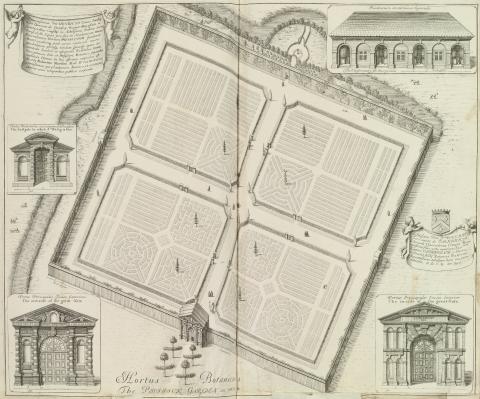
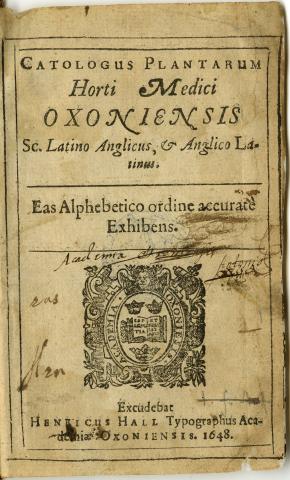
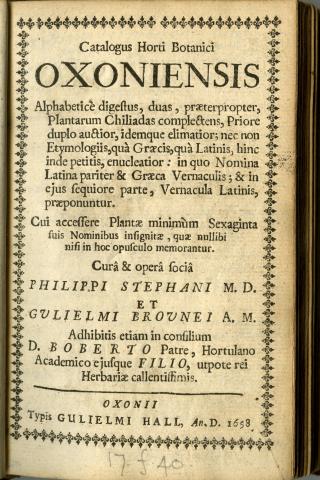

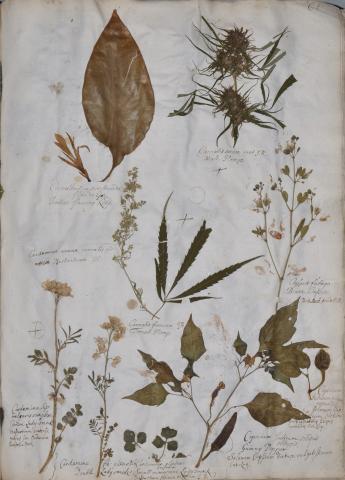
![Image for Herbarium specimen labelled ‘Malva hortensis major simplex. Single Hollyhocks’ [Jacob Bobart the Younger’s hand] [modern name: Alcea rosea L. (Malvaceae)] from Bobart the Younger’s Hortus Siccus.](https://www.cabinet.ox.ac.uk/sites/default/files/styles/large/public/images/sources/02-04_0.jpg?itok=7Qd9FJbn)
![Image for Herbarium specimen labelled ‘Ranunculus ceratophyllus seminibus falcatis in spicam adactis. Moris. Hist. Oxon. [I] 440 [No. 22] Melampyrum luteum minimum. C.BP. 234.’ [Jacob Bobart the Younger’s hand, with items in square brackets in the hand of Henry Edw](https://www.cabinet.ox.ac.uk/sites/default/files/styles/large/public/images/sources/02-06_0.jpg?itok=wMB0lKKZ)

